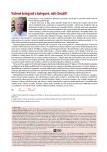Repeated sectio caesarea, over and over: case report
Authors:
Iva Výmolová
Authors‘ workplace:
Gynekologicko-porodnické oddělení Krajské nemocnice T. Bati a. s., prim. MUDr. Z. Adamík, Ph. D.
Published in:
Prakt Gyn 2013; 17(2): 123-127
Category:
Gynecology and Obstetrics: Case Report
Overview
Vaginal delivery after the previous Caesarean section raises a great deal of controversy. Attempted vaginal delivery following the previous Caesarean section has been receiving ever growing attention since the 1980s in relation to the significant increase in pregnancies ended by Caesarean section. The gravest complication relating to vaginal birth following Caesarean section is uterine rupture. Although the complication is rare (0.2-1.5 %), it ranks among the most serious due to its consequences. Further risks are associated with an increasing incidence of placenta pathology (placenta accreta, placenta praevia) following previous caesarean sections. The described case study shows a unique case of a patient with a history of 9 caesarean sections, whose pregnancy and caesarean delivery itself were free of any complications.
Key words:
sectio caesarea – trail of labor – uterine rupture – vaginal birth after caesarean section
Sources
1. Al-Zirqi I, Stray-Pedersen B, Forsen L et al. Uterine rupture after previous caesarean section. BJOG 2010; 117(7): 809–820.
2. Bergholt T, Stenderup JK, Vedsted-Jakobsen A. Intraoperative surgical complication during cesarean section: an observation study of the incidence and risk factors. Acta Obstet Gynecol Scand 2003; 82(3): 251–256.
3. Getahun D, Oyelese Y, Salihu HM et al. Previous cesarean delivery and risks of placenta previa and placental abruption. Obstet Gynecol 2006; 107(4): 771–778.
4. Gilliam M, Rosenberg D, Davis F. The likelihood of placenta previa with greater number of cesarean deliveries and higher parity. Obstet Gynecol 2002; 99(6):976–980.
5. Guise JM, Eden K, Emeis C et al. Vaginal birth after cesarean: new insights. Evid Rep Technol Assess 2010; 191(1): 1–397.
6. Guise JM, McDonagh MS, Osterweil P et al. Systematic review of the incidence and consequences of uterine rupture in women with previous caesarean section. Br Med J 329(7456): 19–25.
7. Hemminki E, Merilainen J. Long-term effects of cesarean sections: ectopic pregnancies and placental problems. Am J Obstet Gynaecol 1996; 174(5): 1569–1574.
8. Hemminki E. Impact of caesarean section on future pregnancy – a review of kohort studies. Paediatr Perinat Epidemiol 1996; 10(4): 366–379.
9. Hibbard JU, Torre MD. Když žena žádá císařský řez. Gynekologie po promoci 2007; 7(3): 19–23.
10. Hofmeyr GJ, Say I, Gulmezoglu AM. WHO systematic review of maternal mortality and morbidity: the prevalence of uterine rupture. BJOG 2005; 112(5): 1221–1228.
11. Landon MB, Hauth JC, Leveno KJ et al. Maternal and perinatal outcomes associated with a trial of labor after prior cesarean delivery. N Engl J Med 2004; 351(25): 2581–2589.
12. Lyndon-Rochelle M, Holt VL, Easterling TR et al. Risk of uterine rupture during labor among women with a prior cesarean delivery. N Engl J Med 2001; 345(1): 3–8.
13. Martin JA, Hamilton BE, Sutton PD et al. Births: final data from 2006. Natl Vital Stat Rep 2009; 58(24): 1–85.
14. Martins WP, Barra DA, Gallarreta FM et al. Lower uterine segment thickness measurement in pregnant women with previous Cesarean section: reliability analysis using two - and three-dimensional transabdominal and transvaginal ultrasound. Ultrasound Obstet Gynecol 2009; 33(3): 301–306.
15. McDonagh MS, Osterweil P, Guise JM. The benefits and risk sof inducing labour in patiens with prior caesarean delivery: a systematic review. BJOG 2005; 112(8): 1007–1015.
16. Miller DA, Chollet JA, Goodwin TM. Clinical risk factors for placenta raia-placenta accreta. Am J Obstet Gynecol 1997; 177(1): 210–214.
17. Mozurkewich E, Hutton EK. Elective repeat cesarean delivery versus trial of labOR a meta-analysis of the literature from 1989 to 1999. Am J Obstet Gynecol 2000; 183(5): 1187–1197.
18. Nielsen TF, Hokegard KH. Cesarean section and intraoperative surgical comlications. Acta Obstet gynecol Scand 1984; 63(2): 103–108.
19. Rooney CM, Crawford AT, Vassallo BJ et al. Is previous cesarean section a risk for incidental cystotomy at the time of hysterectomy? A case-controlled study. Am J Obstet Gynecol 2005; 193(6): 2041–2044.
20. Rosen MG, Dickinson JC, Westhoff CL. Vaginal birth after caesarean: a meta-analysis of morbidity and mortality. Obstet Gynec 1991; 77(3): 465–470.
21. Rozenberg P, Goffinet F, Phillippe HJ et al. Ultrasonographic measurement of lower uterine segment to asses risk of defects of scarred uterus. Lancet 1996; 347(8997): 281–284.
22. Roztočil A. Spontánní porod po císařském řezu. Mod Gyn Por 2006; 15(4): 547–552.
23. Silver RM, Landon MB, Rouse DJ et al. Maternal morbidity associated with multiple repeat cesarean deliveries. Obstet Gynecol 2006; 107(6): 1226–1232.
24. Sobande A, Eskandar M. Multiple repeat caesarean sections: complications and outcomes. J Obstet Gynaecol Can 2006; 28(3): 193–197.
25. Štembera Z. Císařský řez v České republice na začátku 21. století. Gynekolog 2003; 12(5): 202–204.
26. Villar J, Carroli G, Zavaleta N et al. Maternal and neonatal individula risks and benefits associated with caesarean delivery: multicentre prospective study. Br Med J 2007; 335 (7628): 1025.
27. Wu S, Kocherginsky M, Hibbard JU. Abnormal placentation: twenty-year analysis. Am J Obstet Gynecol 2005; 192(5): 1458–1461
28. Zetlin J, Mohangoo A. European Perinatal Health report – data from 2004, EURO-PERISTAT project. Dostupné z WWW: <http://www.europeristat.com>.
Labels
Paediatric gynaecology Gynaecology and obstetrics Reproduction medicineArticle was published in
Practical Gynecology

2013 Issue 2
Most read in this issue
- Repeated sectio caesarea, over and over: case report
- Guidelines for the thyroid diseases diagnosis and management in pregnancy and women with fertility disorders
- Complications after ovarian stimulation in vitro fertilization require admission to surgery
- Myoinositol – new possibility in treatment of polycystic ovary syndrome
